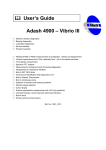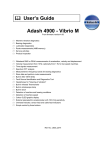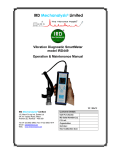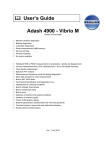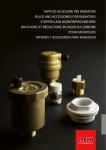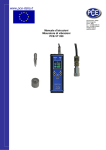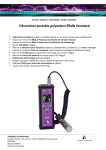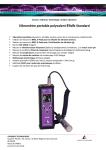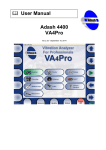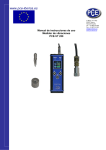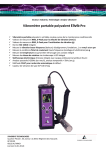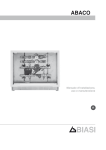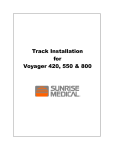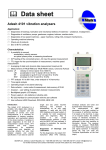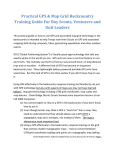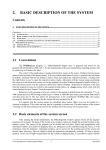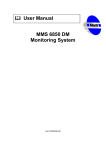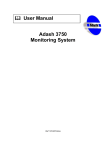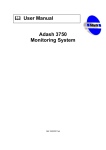Download Adash 4900 – Vibrio III ffl User`s Guide
Transcript
User’s Guide Adash 4900 – Vibrio III Built-in FASIT Expert System ! Machine vibration diagnostics Bearing diagnostics Lubrication diagnostics Service activities Product Inspection FASIT - Fault Source Identification Tool ( see details inside) Spectrum FFT analysis Measurement of time signals Built-in stroboscope lamp Determination of machine and bearing conditions Detection of speed Wideband measurements RMS or PEAK acceleration (g) and velocity (mm/s) values Measurement in frequency bands for bearing diagnostics Colour display Simultaneous display of two measured values External piezoelectric accelerometer with 100 mV/g sensitivity Overload indicator, sensor fault and cable fault indicators Possibility of connecting headphones for "listening of vibration" Built-in torch Simple control by three buttons Ref. No.: 240709 ADASH Ltd. Adash 4900 – Vibrio III Contents Why perform vibration diagnostics ......................................................................................4 Vibration Diagnostics - Basic Information...........................................................................5 Introduction ..........................................................................................................................5 Basic Rules..........................................................................................................................5 Machine and bearing condition diagnostics.........................................................................6 Methods for ball bearing condition diagnostics....................................................................6 The relation between gears and ball bearings.....................................................................6 FASIT - Fault Source Identification Tool..............................................................................7 Measurement Points............................................................................................................7 The preparation of the measurement point..........................................................................8 Listening to Vibrations Using Headphones..........................................................................9 Relationship of Measuring in Acceleration and Speed ........................................................9 Abbreviations used in the guide...........................................................................................9 What Will You Get with Your Instrument ...........................................................................10 Instrument and accessories...............................................................................................10 Before You Start ...................................................................................................................11 Standards for vibration measurements .............................................................................12 Adash Limit Values of Machine and Bearing Vibrations ....................................................13 ISO 10816 limit values.......................................................................................................14 Classification according to machine type, nominal power or shaft height.................................. 14 Classification according to foundation ........................................................................................ 14 Evaluation ranges ....................................................................................................................... 14 Classification of vibration values for machines groups 1 and 3 ................................................. 15 Classification of vibration values for machines groups 2 and 4 ................................................. 15 Values setting in A4900 Vibrio III unit ................................................................................15 Quick Start ............................................................................................................................16 Preparation of Measurement Point ....................................................................................16 Putting in Batteries.............................................................................................................16 Plugging in Vibration Sensor .............................................................................................17 Connectors ........................................................................................................................18 Measuring ..........................................................................................................................18 Automatic determination of the machine speed.................................................................18 Evaluation of the machine and bearing conditions ............................................................18 Fasit Expert System...........................................................................................................19 The Stroboscope ...............................................................................................................19 The Torch ..........................................................................................................................20 Instrument Operation...........................................................................................................21 Switching on and off ..........................................................................................................21 Information line ..................................................................................................................22 Using of Headphones ........................................................................................................22 Selection of Measurement .................................................................................................23 Measurement Methods Screens........................................................................................23 Speed detection and definition ..........................................................................................25 Menu for functions selection ..............................................................................................26 LIGHT ......................................................................................................................................... 26 STROBO..................................................................................................................................... 27 VOLUME..................................................................................................................................... 27 SETUP........................................................................................................................................ 28 SPEED........................................................................................................................................ 28 ALARMS ..................................................................................................................................... 28 2 Further technical and contact information can be found at www.adashusa.com, www.adash.cz ADASH Ltd. Adash 4900 – Vibrio III UNITS ......................................................................................................................................... 29 -ESC- .......................................................................................................................................... 29 Error Messages .................................................................................................................30 Sensor connection Error ............................................................................................................. 30 Overload Error ............................................................................................................................ 30 Measurement Error..................................................................................................................... 31 How to evaluate the failure..................................................................................................32 Overall RMS values ...........................................................................................................32 Overall PEAK values .........................................................................................................33 Spectrum 200 Hz– Detection of Looseness .....................................................................33 Time signal for bearing condition evaluation .....................................................................34 Vibrations on frequency range – gearboxes/bearings. ......................................................36 FASIT Expert System ........................................................................................................39 Specifications Adash 4900 – Vibrio III................................................................................40 3 Further technical and contact information can be found at www.adashusa.com, www.adash.cz ADASH Ltd. Adash 4900 – Vibrio III Why perform vibration diagnostics A4900 Vibrio III instrument is able to do all required basic vibration diagnostic measurements. That means bearing condition, lubrication, mechanical faults ( misalignment, unbalance, mechanical looseness and resonance). The instrument performs a lot of operations automatically. It’s possible to connect ear phones to listen vibration signal, which is very useful for gearbox and slow running roller bearing diagnosis. The instrument is able to measure machine vibration very precisely, to determine condition, its source and level of damage. The instrument is designed to be a standard technicians and maintenance staff equipment. Vibration diagnostic allows checking the condition of all your machinery. You will be informed early about potential failure before the machine get damage and you will be able to order only real specific required maintenance (instead of expensive overhauls). The periodical measurements will allow you to keep your machines in good health. You always ask before the decision to buy new instruments what unit is the best for your needs. Is it a instrument with a large amount of functions, including specialized software for data processing (which you will not ever use), or is it an instrument which is easier to use and contains all required functions? You should pay only for functions, which you will use in the field. The A4900 - Vibrio III is just that instrument. The instrument uses standard external accelerometer with the magnetic base. It enables correct repeatable measurements. You should not equate our unit with "vibration pens". 4 Further technical and contact information can be found at www.adashusa.com, www.adash.cz ADASH Ltd. Adash 4900 – Vibrio III Vibration Diagnostics - Basic Information Introduction What is it the vibration diagnostics? This chapter explains the basic steps and you will be able to begin practical measurements. More information you can find in the literature. If we are talking about the vibration diagnostics, we mean regular measurements (usually every 2-4 weeks), whose objectives primarily are: 1. Finding of change of vibration level, it means change of machine operational condition. 2. Determining reason for this change. 3. Recommending maintenance (repair, adjustment, lubrication etc.). 4. Checking of maintenance success (including revision of dismantled part to confirm the analysis). The machine vibration diagnostics solves two basic tasks: 1. Diagnostics of machine mechanical failure (imbalance, misalignment, mechanical loosenes etc.). 2. Diagnostics of rolling bearing condition. Basic Rules 1. If the measured value of vibration increases in time, it is a change indicator - worsening of the machine condition. 2. If the measured values do not change, the machine works in stable operation condition. This does not necessarily mean that this state is good. For example if a bearing was installed incorrectly, then there would be a high signal value immediately. This value will remain stable for some time (the bearing will be able to withstand it), but then there will be a fast increase and destruction of the bearing. This short bearing life can take hours, days, weeks or even months. 3. Reliability of the diagnostics will never be 100%. There will always be defects, which develop in time shorter than regular measurements. The defects that are caused by material fatigue can develop in several seconds only (cracks, breaks). The proof of the diagnostic performance is primarily a decrease in maintenance costs (not to absolute zero) and a significant decrease in unexpected breakdowns (not their complete elimination). 4. Using of standards is possible only with special machines, for which the special standards exist. It is not possible to simply define limit vibration values in general for a wide range of machines. However, it is possible to create the standards for special machines (e.g. turbines), and these standards are a strong diagnostic tool. General standards have a character of recommendation on how to define the limit values. The way how to find the good condition values is to use measured values of new or repaired machine. Also you can ask the machine producer for them. 5. Shortening of an interval between measurements means more successful prevention of unexpected failures. 5 Further technical and contact information can be found at www.adashusa.com, www.adash.cz ADASH Ltd. Adash 4900 – Vibrio III Machine and bearing condition diagnostics Basic defects which we’d like to find out are - unbalance (heavy spot on the rotor causes vibrations), - misalignment (machinery parts are not in alignment ), - looseness (machine is not properly connected with its base - soft foot), - bearing defect (wear of bearing, bad assembly, bad lubrication or overload). First three defects influence the whole machine (e.g. the vibration caused by unbalance we can take from any point on the machine). We use the vibration velocity [mm/s] measurements for that. Roller (ball) bearing condition we can detect only on the nearest point. This is the local failure. We measure always vibration acceleration only [g]. Methods for ball bearing condition diagnostics We can find out several methods for bearing condition detection in literature. We should repeat again: we have to measure vibration acceleration in [g] for correct data acquisition. All methods must satisfy the conditions. We can choose different procedures for evaluation of the acceleration signal. Measured signal can be imagined as a level of the river. It flows with appropriate speed and there are little or big waves. If we want to measure the stream we can measure the flow per hour or prompt wave's level. The value of the flow will be stable and it will change slowly. But the wave's levels are unstable because measurements have significant variety of values. The similar effects occur for bearing condition measurements. You can measure RMS value (the total energy in signal) or PEAK value (the highest peak in signal). We can use both types for evaluation, just have to realize of advantages and disadvantages. RMS measurement - advantages - disadvantages PEAK measurement - advantages - disadvantages - stable and well repeatable, time trends are well readable - if wear increases the response is slower then PEAK, but sufficient for maintenance. - fast response for any condition change. - not stable and well repeatable (extremely sensitive), time trends are not well readable. From these two basic measurements further measurements are derived: - gENV - envelope signal modulation. Advantages and disadvantages are in the middle of RMS and PEAK measurements. - gSE BCU, SEE, SPM - measurements are performed usually on the sensor resonance frequency. These methods have the same advantages and disadvantages like the PEAK measurement. The relation between gears and ball bearings For gearboxes diagnose it is also necessary to measure acceleration signal like for ball bearings. When the balls are rolling over the damage tracks (pitting), the shock pulses occur in signal. Unfortunately similar shocks are also in signal from on worn or damaged gears. So if we measure gearbox with roller bearings then higher vibration values can be caused by both sources. More information for this kind of analysis you can find in chapter Vibrations in frequency range gearboxes/bearings. 6 Further technical and contact information can be found at www.adashusa.com, www.adash.cz ADASH Ltd. Adash 4900 – Vibrio III FASIT - Fault Source Identification Tool The FASIT is also included in the Adash 4900 Vibrio III. The name FASIT is used in more Adash products for expert system, which would help the user to find the source of vibration troubles. It is good message for users, because such functions were not ever built-in the instrument in this price category. The FASIT displays several bar graphs with traffic light colours. Two major (largest) bars are allocated to general machine condition ( on the left side) and ball bearing condition (on the right side). The next three bars are located in the middle. They displays the severity level of UNBALANCE, LOOSENES and MISALIGNMENT (from the top). Measurement Points The measurement location must enable repeatable measurements under the same conditions as the previous measurement. Also the direction of sensor ( radial, axial for rotated machines) is important. That is why you we should determine measurement points on the machine. The typical machine together with the measurement points in the picture. For the measurement in radial direction, we are going to place the sensor perpendicularly to the axis of rotation, for axial measurement along the axis. The radial measurement can usually be performed horizontally, vertically or in another angle. The importance of the angle choice should not be overstressed; choose any radial direction with easy access. The measurement points need to be prepared for the measurements. The best is to place measuring pads on a machine (see the chapter Preparation of Measuring Location). 7 Further technical and contact information can be found at www.adashusa.com, www.adash.cz ADASH Ltd. Adash 4900 – Vibrio III The preparation of the measurement point On the measurement point we make a measurement. To obtain a quality measurement, the points for measurements must be prepared in advance. For regular measurements the sensor must be always fixed in the same way at the same point. For diagnostics of bearings it is necessary to fix the sensor with a magnetic base. Do not push the sensor only by hand - high frequencies cannot be measured in this way. The magnetic base is firmly screwed to the sensor and then it is magnetically fixed to the metal surface of the machine. Hence the sensor is fixed and a measurement is possible. Quality of fixation markedly influences the result of your measurement. If the sensor swings or jumps about etc., your measurement is pointless. A layer of paint is also a big obstacle for higher frequencies. The magnetic base has ground surface and the same surface quality must be created on the machine. In practice, it is not possible. A flat surface 3x3 cm in size can be ground only in a workshop. Anyway, quality of the bearing’s housing steel is not high and such a surface can quickly succumb to corrosion. Then it becomes unusable. Solution to this problem is to use measurement pads. These are the cylinders with the diameter approx. 26 mm and height 10 mm with a ground surface, made of a magnetic stainless steel. They are fixed to chosen points with special glue, which ensures a perfect transmission of the high frequency vibrations. The pad is covered with a plastic cover, which is removed only for the measurement. Another advantage of the cover is that when the machine is painted, your measurement point is preserved. The paint would devalue the pad. It is sufficient to coarsely grind the machine’s surface and degrease it before the pad is glued. Durability of the pads in time is unlimited. In practice, it is always until a forcible removal. You will need mainly the following aids: angle grinder, set of files, emery paper, degreaser (ethanol, solvent), measurement pads and glue. Prepare the surface in the following way: - remove the paint, corrosion or unevenness from the surface by grinding, - degrease the surface. The pad is being fixed on measurement point with the glue. We usually use the METAL TECH SG cement, also other glues with similar properties may be used. The METAL TECH SG cement is a 2-component epoxy cement with properties best suited for this task. The two components, after mechanical mixing, chemically react and after drying they form a hard material resistant to pressure, temperature and humidity. In the case of the simple pad the procedure is as follows: cut-off a disc approx.3 mm thick from the cement with a sharp knife. Wet your fingers and work the disc into a homogenous lump. Roll a cylinder with the diameter approx. 2-3 mm from this lump and put it on the side, which is not roughened. 8 Further technical and contact information can be found at www.adashusa.com, www.adash.cz ADASH Ltd. Adash 4900 – Vibrio III Push the pad with glue to the prepared place and, while constantly pushing and turning the pad there and back with circular movements, observe that the cement is being evenly pushed out along the circumference of the pad. The purpose is to make the layer between the pad and the surface as thin as possible. ! ATTENTION. CEMENT MUST NOT BE PUSHED OUT COMPLETELY! The pushed out cement may be removed or levelled out around the pad. In the end you put a cover on the pad. When using the T pad, amount of the cement is dependent on the size of the gap between the ribs and it is not so easy to determine amount of the cement to process. As with the simple pad, the surface between the ribs must be well cleaned and degreased. The space shall be filled with the necessary amount of the cement so that only the cylindrical part of the pad remains visible after drying of the cement. Beetle in the surrounding cement. In the end put a cover on the pad. Listening to Vibrations Using Headphones A user can connect headphones to the Adash 4900 – Vibrio III instrument, since listening to a measurement signal also enables a differentiation of a problem type. People can think that this is an old method, which does not have a place in this modern world. The opposite is true. Analyses of gears and low speed bearings (e.g. in paper mills) gain better quality by using the listening method. The listening can easily be done by any maintenance person without deeper knowledge of diagnostics. If there is a defective bearing, then distinct rumbling sound is audible in the headphones. If the bearing is OK, then you can hear only a weak noise. HEADPHONES WARNING ! Listen at moderate volumes to avoid hearing damage. Always remove the headphones from the ears when you move the sensor or re-connect cable. Relationship of Measuring in Acceleration and Speed Maintenance staffs usually use to measure often only vibrations in mm/s or inch/s (velocity) and not vibrations in g = 9.81 m/s2 (acceleration). This is a relic of the past, when old equipment enabled the vibration speed measurement only. Bearing defects are not recognisable by using velocity measurements. If the velocity value increases due to a bearing defect, then the defect is already serious and there is an acute danger of unexpected breakdown. The measuring of the velocity vibration does not give early enough warning before failure of a rolling bearing. For accurate bearing condition measurement you have to measure the acceleration vibration! Abbreviations used in the guide Abbreviations below are used in the User’s guide RPM CPS RMS PEAK – Revolutions per minute – Revolutions per second – RMS value of the measured signal – Peak value of the measured signal 9 Further technical and contact information can be found at www.adashusa.com, www.adash.cz ADASH Ltd. Adash 4900 – Vibrio III What Will You Get with Your Instrument Instrument and accessories The instrument case contains: - measuring instrument A4900 – Vibrio III - vibration sensor - accelerometer - magnetic base for vibration sensor - coiled cable to connect vibration sensor - headphones - measuring tip for putting manual pressure on vibration sensor - 1.5V alkaline batteries Fig. Adash 4900 – Vibrio III with accessories 10 Further technical and contact information can be found at www.adashusa.com, www.adash.cz ADASH Ltd. Adash 4900 – Vibrio III Before You Start Ignoring any of the recommendations mentioned below may cause failure of the instrument. Handling voltage higher then 24 V can cause an accident. 1. Always connect only ICP type of sensor into an ICP marked socket ! If unsure, consult the procedure with your supplier. 2. Never plug this instrument into 230 V household voltage ! 3. To power this instrument, use batteries with max. nominal voltage of 1.5 V! 4. To power this instrument, use only alkaline or rechargeable (NiCd, NiMH) batteries. Regular carbon-zinc batteries are not suitable. WARNING! Use correct battery polarity. Incorrect polarity will cause destruction of the instrument! HEADPHONES WARNING! Listen at moderate volumes to avoid hearing damage. Remove the headphones from the ears when you move the sensor or re-connect cable. 11 Further technical and contact information can be found at www.adashusa.com, www.adash.cz ADASH Ltd. Adash 4900 – Vibrio III Standards for vibration measurements Standards using is occasional topic in vibration diagnostics. Because there are a lot of different types of machines it is impossible to determine the critical limits of vibrations for wide range of machines. Its reliability would be low then. It would happened the decommissioning and repair machines, which do not require it. On the other hand there would be unacceptable breakdowns, because measured values could be high but not exceeded the limit. The standards should be determined for a narrow range of machines. A4900 Vibrio III contains Adash limit values. They are not rewritten from any existing standards. It’s a result of 20 years of Adash engineering team experiences. It’s difficult to invent critical value definition which would be simple (that means not many parameters such as speed, power, bearing type, machine type and so on) and reliable. On the figures below is clear how we derived limit values. Three levels of machine condition are defined: GOOD, ALERT (Machines lays in this range are not acceptable for a long period operation, they could be operated till time when could be repaired) and DANGER (Vibration values in this range are considered as very dangerous an they can cause a damage of the machine). The corresponding colors are taken from traffic semaphore - green, amber and red. GOOD state is the space up to the yellow line that means operation without restriction. The space above yellow but under red line is an ALERT state. Possible to operate the machine but have to be more checked. It’s necessary to determine the source of worse condition and plan repair (for instance change the bearing) or maintenance (balancing, alignment). The space above red line is an DANGER state and the machine should not be operated. First figure contains the values for overall machine condition and you search unbalance, misalignment, and mechanical looseness above all. They are called “overall” because we can measure them on most of the measuring points. Second figure contains the limit values of a roller bearing condition. This state is local and can be measured only on appropriate bearing house. Work with figures is simple. It’s necessary to know the speed. Instrument determines it automatically or user can enter it manually. On the bottom horizontal axis you should find the point which corresponds with speed. Above this point you will find an intersection with orange and red graph. Projections to the vertical axis will determine limit values for amber or red state. If the measured value is lower than amber the state is GOOD – green. If the value is above amber but under red then the state is ALERT – amber. If the value is higher then red graph then the state is DANGER – red. 12 Further technical and contact information can be found at www.adashusa.com, www.adash.cz ADASH Ltd. Adash 4900 – Vibrio III Adash Limit Values of Machine and Bearing Vibrations 6.0 0.24 5.0 0.2 4.0 0.16 3.0 0.12 2.0 0.08 1.0 0.04 0.0 0 500 1000 1500 2000 2500 3000 Vel (10-1000Hz) [ips RMS] ----> Vel (10-1000Hz) [mm/s RMS] ----> Graphs, according to which the instrument determines acceptable vibration limits depending on machine speed. 0 4000 3500 speed [RPM] ----> 3.5 Acc (5k-16kHz) [g RMS] ----> 3.0 2.5 2.0 1.5 1.0 0.5 0.0 0 1000 2000 3000 4000 5000 6000 7000 speed [RPM] ----> 13 Further technical and contact information can be found at www.adashusa.com, www.adash.cz 8000 ADASH Ltd. Adash 4900 – Vibrio III ISO 10816 limit values There is a wide range of valid standards but we would like to mention ISO 10816. It has several sections and it also deals with procedures how to gain limit values for particular machines. It contains 3 tables of values, which are applicable for A4900 VibrioIII unit. Classification according to machine type, nominal power or shaft height Therefore, select the Group that best describes the general size, type, and speed of the machinery being measured. Note that these machine group classifications are set forth in ISO 10816-3, which rates overall velocity vibration levels for standardized machinery classifications. Group 1 and 3: ISO Group 1 and 3 classifications define the following type of machinery: Large machinery and electrical machines with a shaft height greater than 315 mm. These machines are generally equipped with sleeve bearings, but may use rolling element bearings.These machines include pumps with multi-vane impellers and integrated drivers. Group 2 and 4: ISO Group 2 and 4 classifications define the following type of machinery: Medium-sized machines and electrical machines with a shaft height between 160 and 315 mm. These machines are normally equipped with rolling element bearings, but may use sleeve bearings, and operate at speeds above 600 RPM. These machines include pumps with multi-vane impellers and integrated drivers. Classification according to foundation An additional setting allows the specification (when defining the overall alarm levels) of measurements taken from machinery with Rigid or Flexible foundations. Evaluation ranges For evaluation of the machine health from vibrations there are defined following evaluation ranges. Range A: New machine vibrations should occasionally be in this range. Range B: Machines in this range can be operated for unlimited period. Range C: Machines in this range are not acceptable for a long period operation, they could be operated till the repair time only. Range D: Vibration values in this range are considered as very dangerous an they can cause a damage of the machine. 14 Further technical and contact information can be found at www.adashusa.com, www.adash.cz ADASH Ltd. Adash 4900 – Vibrio III Classification of vibration values for machines groups 1 and 3 Foundation class RMS velocity values mm/s border zone Rigid (R13) 2,3 4,5 7,1 A/B B/C C/D Flexible (F13) 3,5 7,1 11,0 A/B B/C C/D Classification of vibration values for machines groups 2 and 4 Foundation class RMS velocity values mm/s border zone Rigid (R24) 1,4 2,8 4,5 A/B B/C C/D Flexible (F24) 2,3 4,5 7,1 A/B B/C C/D Values setting in A4900 Vibrio III unit It’s possible to set up these values directly in the unit. Then the measured values are displayed in traffic light colors. You can choose Adash limits (recommended) or 10-816 limits. Setting up is in menu under the mode SETUP (see instrument operation). Colored marks according 10-816 are range A and B is displayed by green color. Range C is amber and range D is red. It’s necessary to choose a type of evaluation R13, F13, R24 or F24 (see table above). 15 Further technical and contact information can be found at www.adashusa.com, www.adash.cz ADASH Ltd. Adash 4900 – Vibrio III Quick Start The aim of this chapter is to introduce you to this instrument, and, without reading a complete User’s Guide, enable you to measure first vibration values. This chapter does not intend to fully and in detail describe operation of this instrument or measurement methodology. Special chapters in this Guide are intended for this purpose. Preparation of Measurement Point We have to select a measurement point before the measurement itself. We want to choose it in such way that transmission of vibrations would not be attenuated. Usually this means as close to the source of vibrations as possible (for instance at a bearing housing). We always have to measure at solid, firm part of a machine. We should not be measuring on covers and so on. The place should be clean, without corrosion and paint. It should also be flat so a sensor would not “wobble”. The best is to use a measurement base, which is glued on a machine. It has a perfect finish, plastic cover, and is made from magnetic stainless steel. This will enable you to perform the measurements on the machine at any time under the same conditions. This measurement repeatability means that you will be able to compare the values well. To attach the sensor use a magnetic sensor base (do not forget to remove a magnet cover from it, which closes a magnetic field and protects the magnet from long-term weakening in storage). Putting in Batteries Batteries are accessible after opening a lid at a bottom part of the instrument. Open the lid by pressing its lower edge (the edge with hinge), the lid upper part opens easily - see figure. Do not ever use force! Proper polarity is shown on the picture. Do not forget to switch the instrument off before opening the power battery lid! Never handle the power batteries with the instrument switched on! 2. Open 1. Press gently Fig. Opening of the lid 16 Further technical and contact information can be found at www.adashusa.com, www.adash.cz ADASH Ltd. Adash 4900 – Vibrio III Fig. Placement of power batteries Fig. Proper cell polarity Plugging in Vibration Sensor To measure a vibration signal we need to plug in the vibration sensor with ICP power. The plugged in sensor must be a standard accelerometer with 100 mV/g sensitivity. The instrument is equipped by its own source of ICP power for connected sensor. The sensor needs to be connected at the right input plug by a supplied cable. Fig. The instrument with a sensor connected 17 Further technical and contact information can be found at www.adashusa.com, www.adash.cz ADASH Ltd. Adash 4900 – Vibrio III Connectors connector to plug in the sensor connector to plug in headphones (stereo jack 3.5mm) Fig. Top view of connectors Measuring Screw the sensor onto the magnetic base. Do not forget to remove the plastic cover and a metal washer (it closes a magnetic field for longer service life of the magnet) before measuring. Place the plastic cover and the metal washer back on the magnet after measuring. Place the magnet on a measuring point very carefully. Best is to rest the edge of the magnet on its side and then slowly lower the sensor onto a machine. If you bring the magnet near to the machine with its whole area hitting the machine all of the sudden, then the strong impact can irreversibly destroy the sensor. In case you use a measuring tip instead of the magnet, measured values are not going to be stable. This in not surprising. The measured values depend to a large extent on a pressure of the tip at the measurement point. The magnet that attaches the sensor generates a constant pressure so the values are stable. Attention!!! Use the measuring tip only in hard to reach places, where it is not possible to place the magnetic base. Automatic determination of the machine speed It’s important to know the speed for evaluation of the machine condition. Instrument is looking for speed in the frequency spectrum (200Hz range).It is assumed that most of the vibration energy is located on the speed frequency. If the instrument finds significant energy level on one frequency (that means in very narrow band) then this frequency is labelled as the speed frequency. From this description is clear that the speed has not to be found always. If the higher level of energy is located in the spectrum on other line then speed frequency (for example frequency of the fan blades), then the wrong result can be displayed. But the correct speed, which must be defined for condition levels, can be also entered manually. Evaluation of the machine and bearing conditions Diagnostician is always asking a basic question after measurement: “What condition of the machine should I assign to this measured value?” Machine conditions are divided into 3 levels, which have the same colours like traffic lights: 1. GOOD – GREEN COLOUR Machine is in good condition, no defect is found. The operation is without restrictions. 2. ALERT - AMBER COLOUR The beginning defect is found on the machine. It is possible to operate with paying more attention and planning of repair. 3. DANGER – RED COLOUR There is a serious defect found on the machine. Machine shouldn’t be in operation. 18 Further technical and contact information can be found at www.adashusa.com, www.adash.cz ADASH Ltd. Adash 4900 – Vibrio III Special functions are included in the instrument for the determination of that three states. The overall vibration values are colored with appropriate color. The vibration limits Adash for each state are determined from the graphs, which are printed in the Adash Limit Values of Machine and Bearing Vibrations chapter. Fasit Expert System Press the left arrow on the screen No.1 and the FASIT screen appears. For correct evaluation the speed must be defined. The instrument can do it automatically or by user manual entry. In the left bottom corner you see the Machine icon. The vertical bar displays the general (overall) machine condition. This condition can be evocated by many reasons. The unit evaluates the severity of 3 sources, which are the most occurred in the practise: - the Unbalance ( the circle with heavy spot icon), - the Looseness ( the shoe icon) - the Misalignment ( the clutch icon). Correspondent faults horizontal bars are in middle. On the right bottom corner you find the rolling bearing icon. The vertical bar displays the bearing condition. The Stroboscope The build-in stroboscope inside the A4900 Vibrio III represents the unique innovation in the handheld vibration analyzer field. We use the high lighting LED technology, which low power consumption enables to use the stroboscope in our instrument. Stroboscope or stroboscopic lamp, commonly called a strobe, is the device which produces regular flashes of light. When we have to study or to visually inspect the machinery, which have cyclically moving parts, then the stroboscope enables to froze the moving ( usually rotation). Imagine the simplest form, a rotating disc with one-spaced hole. When the flashes of light are synchronized with the rotational speed of the disc, then just one flash is made during one rotation. It means, the disc is lightened up when the hole is always in the same position. It is the principle of illusion of frozen movement. See the Menu chapter for details. 19 Further technical and contact information can be found at www.adashusa.com, www.adash.cz ADASH Ltd. Adash 4900 – Vibrio III The Torch You sometimes need to inspect or read the dark corners. In that time you are lucky with A4900 - Vibrio III, because this instrument has built-in torch in front panel. See the Menu chapter for details. 20 Further technical and contact information can be found at www.adashusa.com, www.adash.cz ADASH Ltd. Adash 4900 – Vibrio III Instrument Operation Switching on and off The instrument is switched on by pressing of the middle button marked with . Instrument on / off button Fig. Buttons / Switching the instrument on Provided that batteries with sufficient voltage are placed in the instrument then a display will show an instrument Logo. If the batteries are weak the VIBRIO sign is bordered in red. Fig. Switching on with Fig. Switching on with weak batteries Fig. Switching off The instrument is switched off by pressing and holding the same button for a longer time. Before the instrument switches of the sign POWER OFF… lights on the display, slowly goes out, and the instrument switches off if you release the button. 21 Further technical and contact information can be found at www.adashusa.com, www.adash.cz ADASH Ltd. Adash 4900 – Vibrio III Information line After powering on the display shows measured data. Beyond descriptions of the measured values and their actual values the display shows an information line in its upper part. Fig. Information line on a display Meaning of Displayed Symbols: - moving “wave” signifies measurement in progress, - setting of headphone output volume is indicated by yellow colouring of the bars, - this symbols shows an approximate battery status. The more is the symbol filled in, the more battery power remains. If the status goes under 20 %, the remaining energy shows in red, if it is insufficient, the symbol is red and the instrument switches itself off. Battery status symbol: 100% approx. 50% under 20% just before switching off Using of Headphones The instrument is equipped by a 0.5 W amplifier for connecting of headphones and listening to a measured signal. We can connect the headphones by a stereo 3.5 mm jack marked phones on the top of the instrument (see figure in the Connectors chapter). After connecting we can hear a signal from the vibration sensor in the headphones. Advisable volume can be set-up by the VOLUME item from the instrument menu (see MENU chapter) Decrease volume button Increase volume button Switch measuring / volume control button 22 Further technical and contact information can be found at www.adashusa.com, www.adash.cz ADASH Ltd. Adash 4900 – Vibrio III Selection of Measurement A selection of measuring screen (method) can be performed by the buttons ▼ ▲. After press of a button an “empty screen” is shown without measured data, and the measuring starts. Measuring screen selection buttons Fig. Measuring screen selection buttons Measurement Methods Screens Overall RMS values Measurement of RMS vibration values in the ranges: 10 Hz - 1000 Hz in mm/s, 5 kHz - 16 kHz in g, with estimated value of machine speed frequency. Based on the speed and vibration values the machine condition and a colour of the displayed value - green / amber / red - is determined. Overall PEAK values Measurement of peak vibration values in the ranges: 10 Hz - 1000 Hz in mm/s, 5 kHz - 16 kHz in g, 23 Further technical and contact information can be found at www.adashusa.com, www.adash.cz ADASH Ltd. Adash 4900 – Vibrio III Spectrum 200 Hz–looseness detection FFT analysis of vibrations in the range: 2 Hz - 200 Hz in mm/s RMS, with display of 3 found maximum peaks. The peaks are ranked according to amplitude vibration size. Time signal for roller bearing diagnosis Measuring of time signal and vibrations in the range: 5 kHz - 16 kHz in g. Displays actual measured time signal and gENV value. Vibrations in frequency ranges – gearbox/bearing Measurement of RMS vibration values in the ranges: 0.5 kHz - 16 kHz in g, 1.5 kHz - 16 kHz in g, 5 kHz - 16 kHz in g. Fasit expert system The FASIT screen. It displays the severity levels of machine faults. 24 Further technical and contact information can be found at www.adashusa.com, www.adash.cz ADASH Ltd. Adash 4900 – Vibrio III Speed detection and definition After switch on of the instrument the Screen No.1 appears and the automatic speed detection begins. It must be said - obviously. The user can the automatic speed detection switch off in the Menu. The determination procedure is displayed as running bar in the bottom of screen. The result is also displayed on the bottom. When the automatic speed detection is not successful (see Automatic determination of the machine rotation chapter), the last speed value is loaded from the memory and displayed together with the message <set>. Push arrows, it changes the value of speed with the step 250 RPM. When the correct speed ( or the value near the correct speed) is defined, push Enter button for confirmation. If no pushbutton is used for approx. 4 seconds, then the displayed value is accepted. The word <set> is changed to !MAN! then. This word informs all the time the user, that speed is entered manually. When you need to set exact value and the 250 RPM step is too much, then use the STROBO item from the MENU. If the automatic detection is switch on, this procedure of speed determination runs always when the Screen No.1 appears. When it is switch off, the immediately the <set> message appears. 25 Further technical and contact information can be found at www.adashusa.com, www.adash.cz ADASH Ltd. Adash 4900 – Vibrio III Menu for functions selection button, the instrument menu appears. If the instrument is in the error stage (for By pressing example “SENSOR ERROR“), then some functions are not available. LIGHT - Torch mode STROBO - Stroboscope mode VOLUME - Phone output volume adjustment SETUP - This item opens next item selection: SPEED - Automatic speed detection ON or OFF ALARMS - Selection of standard, which will define limit values UNIT - Unit options for a measuring of a velocity signal (mm/s vs. ips) - ESC - Return to the measuring screen If the error is detected (e.g. “SENSOR ERROR"), then some item are not available. Move between items by pressing ▼ ▲ buttons. Select item by pressing button. Use - ESC for return from Menu. Menu selection buttons Fig.: Instrument MENU. 0 MENU Enter/escape button Fig. Meaning of the buttons Fig.: Instrument MENU in error stage. LIGHT In LIGHT mode it’s possible to use instrument like the torch. Select the LIGHT mode and press button. White LED built-in on the front side begins to light. Symbol of the torch appears on display. Press any button to switch off the light and the instrument starts to measure again. Fig.: Torch mode 26 Further technical and contact information can be found at www.adashusa.com, www.adash.cz ADASH Ltd. Adash 4900 – Vibrio III STROBO In STROBO mode you can use the instrument as the stroboscope. White LED built-in on the front side begins to flash with a frequency, which is set up on the screen. If the speed determination is known, then frequency of flashes is set to that value. By pressing ▼ ▲ buttons you can to also change that frequency manually. The step (1,10,100 RPM) is displayed on the bottom line of the screen. Press the button and the STROBO menu appears. You can switch-off (STOP) the stroboscope or change the step frequency tuning. Escape STROBO mode Preset frequency in RPM and Hz Options of frequency step Preset step ▼▲ increasing / decreasing Fig.: STROBO mode Fig.: STROBO mode menu VOLUME The volume bars appear. The volume is changed by buttons ▼ ▲. When the maximum volume is reached, the symbol will become orange otherwise the amount of yellow filling shows the actual volume. If the headphones are off, the symbol is grey. Next press of the button returns the instrument back to the measurement mode. Switched.off cca 50% Maximum Fig.: Volume adjustment Fig.: Displayed volume During the instrument is switched on or off, the range is changed, the sensor is connected or disconnected, the short unpleasant crack can be heard. This is not a defect of the instrument. Be careful not to overload the headphone amplifier by excessive volume. This will distort a signal in the headphones ! You can use any stereo or mono headphones with nominal impedance higher than 8 Ω. Both output stereo channels are connected to the signal. 27 Further technical and contact information can be found at www.adashusa.com, www.adash.cz ADASH Ltd. Adash 4900 – Vibrio III SETUP Further functions menu appeared. Choose requested function using arrows and confirm by Enter. SPEED Switch on (ON) or switch off (OFF) automatic determination of revolutions function. ALARMS Standards setup, Alert limits (amber color) and Danger (red color) will be defined. See Standards for vibration measurements chapter. 28 Further technical and contact information can be found at www.adashusa.com, www.adash.cz ADASH Ltd. Adash 4900 – Vibrio III Chosen standard is displayed above the machine symbol (F13 in this case). If Adash standard is chosen, nothing is displayed. UNITS Vibration speed unit can be chosen here. mm/s (millimeters per second) and ips (inch per second) are available. Device remembers chosen unit even after switch off. -ESCReturn to the MENU screen. 29 Further technical and contact information can be found at www.adashusa.com, www.adash.cz ADASH Ltd. Adash 4900 – Vibrio III Error Messages Sensor connection Error This error signifies incorrect connection of a sensor, unsuitable sensor type, broken cable etc. Overload Error If an input signal is too strong (higher than 12V peak), and the instrument cannot process it, the overload error is displayed. The instrument is not capable of measuring this signal. 30 Further technical and contact information can be found at www.adashusa.com, www.adash.cz ADASH Ltd. Adash 4900 – Vibrio III Measurement Error If there is a break in communication between measuring and display boards inside of the instrument, this measurement initialisation error is displayed (MEAS INIT). If you see this error, it means that the instrument is malfunctioning and we recommend to send it to the manufacturer for a check. 31 Further technical and contact information can be found at www.adashusa.com, www.adash.cz ADASH Ltd. Adash 4900 – Vibrio III How to evaluate the failure The instrument shows measurement results on several separate screens. We shall describe basic rules for their use. Overall RMS values - Machine symbol - this line shows a RMS velocity vibration value in mm/s or ips, which is excited on the machine by mechanical phenomena related to: - imbalance of rotational parts of the machine (fan wheel, impeller, clutch wheel etc.), - incorrect axis alignment of the assembly – misalignment, - mechanical looseness of individual machine parts, - large free play in seating of rotational machine parts (shaft - bearing, shaft – bearing housing), - clutch free play (e.g. free play on a shaft, pressed out grooves and tongues), - loose or worn out machine anchor bolts, - defective base, - insufficient frame or anchoring flange rigidity, - damage to machine rotation parts - (bent shaft). - Bearing symbol – this line shows a RMS acceleration vibration value on g, which is excited by a condition of bearing. This condition is related to: - time wear of the bearing, - bad lubrication (with new bearings as well), - incorrect installation (with new bearings as well), - abrading of bearing. SPEED - The machine speed is displayed at the bottom part of the screen (if it is available). RPM means revolutions per minute. The instrument performs automatic determination of machine revolutions using a spectrum analysis. This function does not have to be always successful, because the revolutions may not be possible to read for every spectrum. If the speed is not determined, it is not a malfunction. It is hard to do it, for example, in machines with gears. If the speed is available, then and vibration values have been coloured corresponding to vibration limits. Machine conditions are divided into 3 levels, which have the same colours like traffic lights: 1.GOOD – GREEN COLOUR Machine is in good condition, no defect is found. The operation is without restrictions. 2.ALERT - AMBER COLOUR The beginning defect is found on the machine. It is possible to operate with paying more attention and planning of repair. 32 Further technical and contact information can be found at www.adashusa.com, www.adash.cz ADASH Ltd. Adash 4900 – Vibrio III 3. DANGER – RED COLOUR There is an serious defect found on the machine. Machine shouldn’t be in operation Overall PEAK values Similar rules for evaluation of the measured values, as in the previous screen are valid for this screen with one difference. The peak (PEAK) vibration values are displayed. It is highest measured value in certain time, which is important for transient shock events evaluation, especially in cases of incipient bearing defects, like: - microscopic peeling off of a hardened surface layer in the place of a rolling element contact with a bearing ring (regular shocks), - contamination of bearing space by metal particles (irregular shocks), - cracks. The shocks that cause these defects are also parts the RMS vibration values. However, the peak value of such shock is hidden in a value which contains all other information about vibrations, i.e. noise from possible abrading, wrong lubrication and overloading. To simplify, the RMS is an average value of all vibration values achieved in certain time. If a large peak value (one shock) appears in this time period, it will be lost in the final recalculation of all the values. This practically means that during increasing of this bearing defect that causes the shock, the PEAK value of this shock will visibly increase, while the effective (RMS) value will increase only slowly. We can discover the initial defect time of the bearing sooner. But PEAK value is not so stable as RMS value. For bearing condition measurement is the RMS measurement sufficient. Spectrum 200 Hz– Detection of Looseness This screen is important for detection of the the mechanical looseness. When the graph shows a number of lines ( typically 3 or 4) with the same space between them and the first line is on the speed 33 Further technical and contact information can be found at www.adashusa.com, www.adash.cz ADASH Ltd. Adash 4900 – Vibrio III frequency (see the value description in the bottom) the probably the mechanical looseness is the machine problem. The most common causes of this defect are: - soft flanges, - loose anchoring bolts, - cracks in frames – cracked welds, - free play in rotational part seating, - or possibly other problems not related to mechanical looseness, - bent shaft. See also FASIT chapters. Time signal for bearing condition evaluation The time signal of bearing vibrations is displayed. gENV value is under the time signal (envelope modulated signal - see Methods for ball bearing condition diagnostics chapter. Caution – the time signal is displayed as a direct record, not after envelope modulation. Look at three basic screens for easy work with this function. Undamaged bearing: This bearing generates a low amplitude noise only, whose time record shape is steady. It’s necessary to have a look on the range of the graph (left side). Signal could look high but it’s not when the graph range is low (for instance 0,5 g). 34 Further technical and contact information can be found at www.adashusa.com, www.adash.cz ADASH Ltd. Adash 4900 – Vibrio III Undamaged bearing – wrong lubrication: The time record shape is steady too but it has bigger amplitude then previous case. You can clearly see different (bigger) range of the graph (1,0 g) Damaged bearing: There are clearly visible shocks caused by a rolling element coming across the damage like pitting or crack here. The shocks repeat themselves regularly. The range of the graph is different again (2,0 g in this case). 35 Further technical and contact information can be found at www.adashusa.com, www.adash.cz ADASH Ltd. Adash 4900 – Vibrio III Vibrations on frequency range – gearboxes/bearings. When we need to find the failure on not simple machines (e.g. gearbox) then is very usefull to know the vibration values in several frequency bands. The screen No. 6 shows measurement values in three frequency bands: 0.5 – 16 kHz the whole vibration area occurring in transmissions due to friction in bearings, bite of gears, abrasion of limiting rings etc. (beyond low-frequency phenomena the imbalance etc., which we measure using the first four screens) 1.5 – 16 kHz in the area from 1.5 kHz we can find driving wheel gear frequencies of most transmissions 5 kHz – 16 kHz this range is typical for bearing defects, where the high-frequency signal occurs as a consequence of bad lubrication, abrasion, bearing wear or overload. Attention: Please note that the ranges overlap. They all have the upper frequency 16 kHz. What does it mean for analysis? The following examples should help you to understand their significance: - All values are the same: All vibrations are in the last range. If they were in the lower ranges also, the highest range would have to have a lower value. - In the first two ranges the value is the same, the last range value is lower: The vibrations are in the range 1.5 - 5 kHz. They are not above 5 kHz, this would express itself in the last range. They are not under 1.5 kHz, the value in the first range would have to be higher than in the second one. - The first range has the highest value: The vibrations are in the range 0.5 - 1.5 kHz. The reasoning is the same as in the previous example. - The value in the higher range is larger than in the lower one: This must be a measurement error. It is logically impossible to have a higher value in the last range, than in the middle one. The reason is their overlapping. 36 Further technical and contact information can be found at www.adashusa.com, www.adash.cz ADASH Ltd. Adash 4900 – Vibrio III Example. We are going to show the analysis procedure on a signal obtained on a seating of an inlet transmission shaft with the speed frequency 25 Hz (1500 rpm) and with a gear with 65 teeth. So called tooth frequency can be obtained by simple multiplication of the shaft revolution frequency (in Hz) by the number of teeth. fGMF = fspeed * z fGMF gear mesh frequency fspeed speed frequency z number of teeth In our example the tooth frequency is 1625 Hz (so approx. 1,6 kHz). What are the possibilities? Condition 1: The transmission is OK and tooth frequency of 1,6 kHz slightly increases vibrations in the first two frequency ranges. Condition 2: Vibrations are concentrated in the last frequency range 5 – 16 kHz, the vibrations in the last area are the same as in the area, where the tooth frequency shows itself - bearing failure 37 Further technical and contact information can be found at www.adashusa.com, www.adash.cz ADASH Ltd. Adash 4900 – Vibrio III Condition 3: While in the last band the vibration value is very low, in the first two frequency bands the values are very high. Very high probability of gear defect - wear of teeth, - change of bite angle as a consequence of wrong correction, - wrong mutual axis distance of drive and driven shafts, - misalignment of drive and driven shafts. All these phenomena increase vibrations in the tooth frequency. Condition 4: The last screen shows a case, when the vibration may not be excited by a bearing or a gear. Very often these are vibrations of the equipment tied to the mentioned machine. In case of multiple-geared transmissions, however, these can be also the tooth frequencies of the second or third transmission gear. Here we would not be able to do without a detailed analysis, using an instrument with possibility of the spectrum analysis measurement. The measurements on the screen No. 6 can also be used in diagnostics of condition of low-speed rolling bearings. They usually have larger sizes, and when bearing defects occur, the vibrations are radiated in the lower frequency ranges. The screens 1 and 2 then cannot be used, since the used frequency range is identical with the last range on the screen No. 6. The diagnostics of the low-speed bearing will then be much more successful if we use the lowest range 0.5 - 16 kHz. 38 Further technical and contact information can be found at www.adashusa.com, www.adash.cz ADASH Ltd. Adash 4900 – Vibrio III FASIT Expert System The description of the FASIT was made in the beginning of his guide. This screen can be displayed behind the screen No.6 ( right arrow) or simply from the screen No.1 ( left arrow), because it is before the No.1. For correct evaluation the speed must be defined. The instrument can do it automatically or by user manual entry. As it has been described in Screen No.1 section, the machine condition is divided into 3 levels, which have the same colours like traffic lights. The same approach we also use for fault detection. In the left bottom corner you see the Machine icon. The vertical bar displays the overall machine condition. This condition can be evocated by many reasons. The unit evaluates the severity of 3 sources, which are the most occurred in the practise: - the Unbalance ( the circle with heavy spot icon), - the Looseness ( the shoe icon) - the Misalignment ( the clutch icon). Correspondent faults horizontal bars are in middle. On the right bottom corner you find the rolling bearing icon. The vertical bar displays the bearing condition. The meaning of Machine and Bearing bars was described in Screen No.1. What do the colours mean in faults bars? GREEN COLOUR It may surprise somebody, because why to think about faults when the colour is green. But also from low level signal the procedure can read the beginning of the fault. But the operation is without restrictions. AMBER COLOUR The beginning level of defect is found on the machine. It is possible to operate with paying more attention and planning of repair. RED COLOUR There is the serious defect level found on the machine. Machine shouldn’t be in operation. 39 Further technical and contact information can be found at www.adashusa.com, www.adash.cz ADASH Ltd. Adash 4900 – Vibrio III Specifications Adash 4900 – Vibrio III - 1x ICP powered accelerometer 100 mV/g sensitivity Input: Measurements: - RMS, PEAK (10 Hz - 1000 Hz) [mm/s], [um, mm] - Spectrum 200 Hz [mm/s] - RMS, PEAK (500 Hz - 16000 Hz) [g] - RMS, PEAK (1500 Hz – 16000 Hz) [g] - RMS, PEAK (5000 Hz - 16000) Hz [g] - Time signal (500 Hz – 16000 Hz) [g] Display: color OLED display 128 x 128 pixels, diagonal 1.5“ (38mm) Range: max. 80g PEAK Further functions: LED stroboscope (0.17 Hz – 300 Hz, 10 RPM – 18000 RPM) LED torch Output: 1x AC signal 8 Ω / 0,5 W for external headphones (signal listening) Power: 2x1.5V (AA size alkaline batteries) or 2x1.2V (NiMH AA size rechargeable batteries) Dimensions: 150 x 60 x 35 mm Weight: 350 g including batteries (without cable, sensor and magnet) 540 g including batteries, cable, sensor and magnet Accessories: vibration sensor, coiled cable to connect vibration sensor, magnetic clamp for vibration sensor, headphones, recording cable with 3.5 mm jacks, measuring tip for manual pressure on the sensor, 1.5V alkaline batteries, transport case 40 Further technical and contact information can be found at www.adashusa.com, www.adash.cz








































